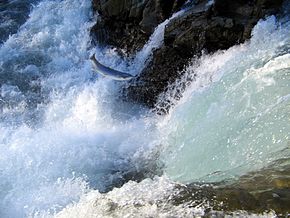
Back هجرة الأسماك Arabic মাছৰ পৰিভ্ৰমণ Assamese Peix migratori Catalan Migrace ryb Czech Fischwanderung German Fiŝmigrado Esperanto Migración de peces Spanish Kalaränne Estonian مهاجرت ماهیان Persian Migration des poissons French

Fish migration is mass relocation by fish from one area or body of water to another. Many types of fish migrate on a regular basis, on time scales ranging from daily to annually or longer, and over distances ranging from a few metres to thousands of kilometres. Such migrations are usually done for better feeding or to reproduce, but in other cases the reasons are unclear.
Fish migrations involve movements of schools of fish on a scale and duration larger than those arising during normal daily activities.[1] Some particular types of migration are anadromous, in which adult fish live in the sea and migrate into fresh water to spawn; and catadromous, in which adult fish live in fresh water and migrate into salt water to spawn.[2]
Marine forage fish often make large migrations between their spawning, feeding and nursery grounds. Movements are associated with ocean currents and with the availability of food in different areas at different times of year. The migratory movements may partly be linked to the fact that the fish cannot identify their own offspring and moving in this way prevents cannibalism. Some species have been described by the United Nations Convention on the Law of the Sea as highly migratory species. These are large pelagic fish that move in and out of the exclusive economic zones of different nations, and these are covered differently in the treaty from other fish.
Salmon and striped bass are well-known anadromous fish, and freshwater eels are catadromous fish that make large migrations. The bull shark is a euryhaline species that moves at will from fresh to salt water, and many marine fish make a diel vertical migration, rising to the surface to feed at night and sinking to lower layers of the ocean by day. Some fish such as tuna move to the north and south at different times of year following temperature gradients. The patterns of migration are of great interest to the fishing industry. Movements of fish in fresh water also occur; often the fish swim upriver to spawn, and these traditional movements are increasingly being disrupted by the building of dams.[3]
- ^ Dingle, Hugh and Drake, V. Alistair (2007) "What Is Migration?". BioScience, 57(2):113–121. doi:10.1641/B570206
- ^ Gross, Mart R.; Coleman, Ronald M.; McDowall, Robert M. (1988-03-11). "Aquatic Productivity and the Evolution of Diadromous Fish Migration". Science. 239 (4845): 1291–1293. Bibcode:1988Sci...239.1291G. doi:10.1126/science.239.4845.1291. PMID 17833216. S2CID 241447.
- ^ Cite error: The named reference
Woo2019was invoked but never defined (see the help page).